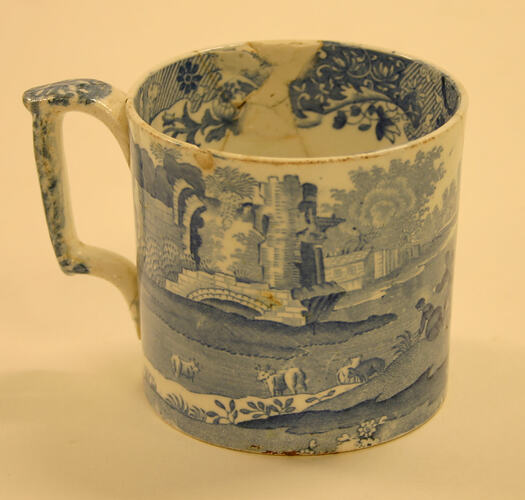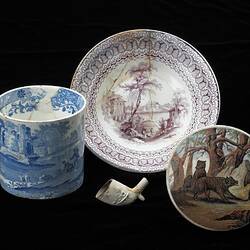Summary
This cup was reconstructed from four fragments which were excavated from the same context at a dig at the Commonwealth Block site between 1988 and 2003. It was manufactured by Copeland and Garrett between 1833 and 1847 at the Spode Works, Stoke-on-Trent, Staffordshire, England. This pattern is known as 'Blue Italian' and the body type is known as 'New Blanche'.
Homewares.
Numerous crockery pieces were found all over the Little Lon site. Crockery gives us a glimpse of everyday life in Melbourne in the 1880s. In the houses around Little Lon, residents used decorated crockery. Most pieces were cheap earthenware or stoneware, yet provided colour and cheer. Only a few could afford to buy matching sets, and most china was probably acquired second-hand. Some were once expensive pieces. Householders mixed and matched their crockery from the great range of mass-produced designs available. 'Blue and white' and the 'willow' pattern, was the most popular choice and was produced by English potteries from 1790.
Physical Description
This is a blue and white transfer print mug which has been reconstructed from four fragments. Border has floral/ geometric design on the inside just below the rim. The outside of the cup depicts an outdoors scene. T
Physical Description
4 fragments of blue and white transfer print mug. Border has floral/ geometric design on upper side below the rim. Manufacturers mark and name of pattern on base reads 'COPELAND & GARRETT...NEW BLANCHE...N' all below a crown. This item has been restored by Conservation and was displayed in the Myer China and Glass Exhibition in April 1998. Pattern: 'Blue Italian'. Copeland and Garrett, Stoke, Staffordshire Potteries, 1833-1847 'New Blanche' is the name of the body type.
More Information
-
Collection Names
-
Collecting Areas
-
Acquisition Information
Transfer from Heritage Victoria, Industry Superannuation Property Trust, 03 May 2005
-
Manufacture Name
-
Manufacture Date
-
Manufacturer
Copeland and Garrett, Stoke-on-Trent, Staffordshire, England, Great Britain, 1833-1847
-
Inscriptions
On base: 'COPELAND & GARRETT...NEW BLANCHE...N' below a crown.
-
Context Number
19/49
-
Site
[CCS] Australia, Victoria, Commonwealth Block, Melbourne
-
Activity
-
Specific Activity
-
Decoration
-
Colour
Blue
-
Moulding
Italian
-
Form
Straight Rim; Chamfered Shoulder Body
-
Shape
Round
-
Provenance
England, Staffordshire
-
Classification
-
Category
-
Discipline
-
Type of item
-
Exhibition Collection Management
84 mm (Length), 109 mm (Width), 79 mm (Height)
-
References
A.W. Coysh & R.K. Henrywood 'The Dictonary of Blue & White Printed Pottery
93 Pages
-
Keywords


